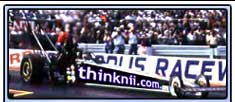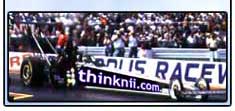|
|
 |
||||||||||
 |
|
||||||||||
GOIN' DEEPBy Dale Wilson Deep will do it -- sometimes. Those of us who race slow bracket cars on the footbrake have learned that in order to get a good reaction time off the starting line, we must deep stage our cars. Something about having less of a running start on the clocks, the theorists say about deep staging, and it's true. In my '73 Datsun, an ex-Super Gas car now racing delay box brackets, a quarter of an inch deep past my "spot" on the starting line will result in a .470-something red light every time. But with racing Footbrake, deep staging is a must in a slow, low-horsepower car. The downside is that deep staging will slow our elapsed times, but that doesn't matter, because we're bracket racing anyway, and shoe polish will take care of that. How do the experts deep stage? We talked to two who race slow cars, the first being Chip Horton of Jesup, Georgia, a remarkable friend who has won 21 track championships over four decades at five different tracks in four eliminators, all with his magic right foot -- he lost his left below the knee in a four-wheel accident when he was a kid. The second is Steve Taylor of Raleigh, North Carolina, who once won or runnered up in three different classes at a Super Chevy Sunday race at Rockingham Dragway, all in a stock Cavalier that was (and is) driven to the track and raced. Even though the NHRA outlawed deep staging at its divisional and national races, you can still deep stage your car in local bracket competition, providing you do a few things first. My advice is No. 1, to write the words "Deep" all over your car in shoe polish or with permanent vinyl letters, to let the track starter know your intentions. If you have to, talk to the starter or track management of your intentions to deep stage, and if they give you any grief, take your racing elsewhere. Deep staging should not interrupt a regular Saturday night's bracket show in the slightest. No. 2, tell your opponent that you're going to deep stage. No. 3, do it as quickly as possible. I always go in and turn on both staging bulbs, then wait until my opponent lights his first before I turn off the top bulb. Then I wait for the last flash of yellow. Worried about the Auto Start? Don't. The Auto Start clock starts to click when three pre-stage bulbs are lit, and even then, it will red light the Christmas tree only after from six to 15 seconds. If someone can't get in after six seconds, there's something wrong. Horton, who races his familiar Footbraked '69 "Trinity" Dodge or a daily-driven slow Lincoln Town Car, leaves on the same spot on the Christmas tree in both cars, even though the Dart is shallow-staged and the Lincoln deep-staged. "I try to get a .520 (reaction time) every time," Horton says. "A .515 is too stout and will go red too much. From a .520 to a .540, you're set to go to win the most races." With "Trinity," Horton slowly rolls into the beams, gets set with his staging spot and then brings up the rpm (he calls it "bowing up the car"). On the days that he is off -- say he's not feeling well -- he will bump into the second staging light. Also, the reaction times he gets on that particular day will determine how much he will roll in on the second bulb. "Let's say that I'm hitting .560s and I need to go to .520s. That will be a two-bump day. I've practiced it enough to know that that's two hundredths per bump, so two bumps will equal four hundredths off my reaction time," he said. With the Lincoln, he rarely goes past three bumps to cut a good tree. What are the factors that affect how Horton stages? Track conditions, how you feel, different rollouts at different tracks, the location of the sun at different times of the day, the background behind the Christmas tree. "Instead of trying to adjust yourself, you need to adjust the car to hit the tree," he said. "Everybody has days that they're on. The trick is to adjust to the days that they're off. Do that and you'll win races." He never brings up the rpm while staging. "You can't bump in when you have the car bowed up," Horton said. He has the idle on both the Lincoln and Trinity set a little high, about 1,200, to roll in clean and quick. One final tip -- "Adjust your car to leave off any kind of flash of the last yellow, like Pro tree racing," Horton said. "Become a reflex racer. You should be to respond to anything in that third bulb and go for a .520 and not hit a red light. The only time you need to adjust from that is a day when you're having a little trouble." For Taylor, his and wife Brenda's fleet of 1990s-era Cavaliers never go below 10.70s in the eighth-mile, yet he has made good money racing them on the Footbrake. Normally he tries to roll from pre-stage well into the staging light, then he is able to bump two or maybe three times to get his spot on the starting line. He also does it quickly, so his opponent doesn't have to wait on him to get that spot.
"I'll light the pre-stage and then wait until my opponent lights his pre-stage, then I'll roll into the staging beam -- well into the staging beam," Taylor said. Then he will bump two or three times more, depending on his needs for that day. The amount he bumps in is determined by the rollout of the track, and he determines that in time runs. Most times, Taylor will have to bump in two small bumps beyond deep. "I have been in as much as four or five," he said. It slows your elapsed time down, but it also gives you a better reaction time, he said. Normally the ratio there will be one-to-one. "If I bump in one-hundredth deeper, my elapsed time will be slowed by one hundredth. If I bump in two hundredth deeper, it will slow my e.t. down two hundredth," Taylor said. "It's one hundredth for one hundredth." At the big B&M Racer Appreciation Series race at Huntsville (Alabama) Dragway over the July 4th holiday, I tried out what I had learned from both Horton and Taylor in our newest race entry, "Little Zoom-Zoom," our 2002 Mazda Protégé 5 yellow wagon. And I'm here to say right now that ... it stunk! Oh, sure, I could cut a good reaction time by deep staging, but on the top end of the eighth-mile, Zoom Zoom scattered elapsed times by as much as two tenths from run to run, making it totally uncompetitive. Unless someone out there in Readerland can tell me how to rig it up to run consistently without losing its warranty, Zoom Zoom has seen its last trips down a drag strip. Our "General's War Wagon" '81 Malibu station wagon will soon be fixed (it has a broken rear end) and returned to action. But even Zoom Zoom responded well in the reaction time department with
some good deep staging tricks. Try them for yourself.
|
|||||||||||
|
|
|||||||||||











